Vij D.R. Handbook of Applied Solid State Spectroscopy
Подождите немного. Документ загружается.

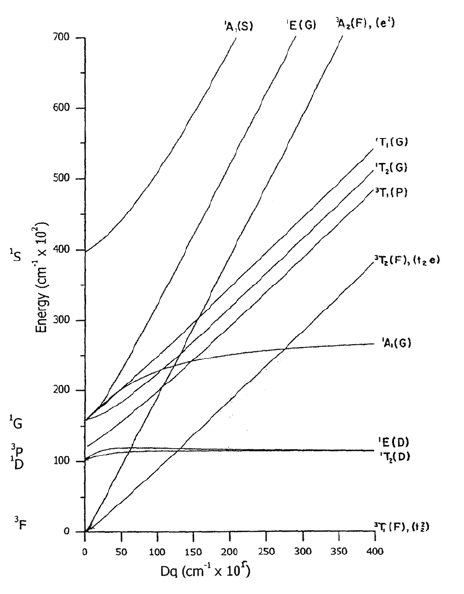
12.4 Localized Systems
531
Including spin, the following labels describe the states:
1
A
1
,
3
A
2
,
1
E,
3
T
1
,
1
T
1
,
3
T
2
,
and
1
T
2
.
The energy of each state depends on the strength of the crystal field. This
dependence is usually depicted in a Tanabe-Sugano diagram [13] of the type
shown in Figure 12.6, which shows the 3d
2
splittings in an octahedral field. At
zero crystal field, the levels are designated according to the free ion spectral
terms, shown to the left of the diagram. In the strong field limit, the slopes of the
lines approach one of three possible values, which are associated with the (t
2g
)
2
,
t
2g
e
2g
, and (e
2g
)
2
orbitals.
Figure 12.6 Tanabe-Sugano diagram for a 3d
2
ion in an octahedral field.
12.4.4.3 Spectral Features of TMI in Solids
Absorption and emission spectra of TMI in solids generally show broad bands,
though sharp lines are occasionally observed. The absorption and emission
spectra of Ti
3+
:Al
2
O
3
are shown in Figure 12.7. The broad bands result from the
3d-electrons’ exposure to the neighboring ions, making the wavefunctions
sensitive to the position of the nearby ions.

12. Luminescence Spectroscopy
532
results in a redistribution of the charge of the 3d-electrons. The neighboring ions
then “see” the new potential and relax to a new equilibrium position. During
relaxation, the center gives up energy to the lattice, usually by emitting phonons.
A similar relaxation process occurs following the emission of a photon. Since
part of the absorbed energy is given up to the lattice, less is available for the
emitted photon.
Figure 12.7 Polarized (a) absorption spectra and (b) emission spectra of Ti
3+
in Al
2
O
3
[12].
12.4.4.4 The Configurational Coordinate Model
The broad bands and large Stokes shift are related to one another, and can be
understood using a configurational coordinate (CC) model [14, 15]. In this
model, each electronic energy level is represented by a parabola on an energy vs.
position diagram (Figure 12.8). The position coordinate can be considered one of
the normal coordinates of the crystal, though it is often associated with the
“breathing mode” of the ligands about the central TMI. The equilibrium position
depends on the electronic state of the system. Horizontal lines within each
parabola represent vibrational levels.
Note the large Stokes shift between the peaks of the absorption and emission
bands. This can be understood in the following way. Absorption of a photon
400
0.0
1.0
2.0
3.0
4.0
5.0
6.0
7.0
450 500
CROSS SECTION (cm
2
)
550 600 650
WAVELENGTH (nm)
WAVELENGTH (nm)
INTENSITY (arb. units)
700
600
0
0.1
0.2
0.3
0.4
0.5
π
π
σ
σ
0.6
0.7
0.8
0.9
1
650 700 750 800 850 900 950 1000 1050
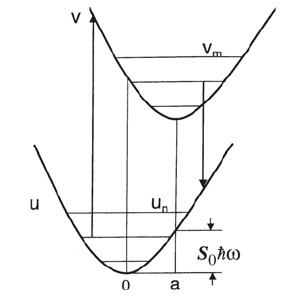
12.4 Localized Systems
533
Figure 12.8 Configuration coordinate (CC) diagram of a two-level system.
The assumptions included in the model are the following:
1. The adiabatic approximation: The electrons and nuclei are separated into
fast and slow subsystems, respectively. The electronic wavefunctions depend
parametrically on the position of the nearby nuclei. The motion of the nuclei is
determined by a potential defined by an average position of the electrons.
Physically, this is justified by the fact the mass of the electron is much less than
the nuclear mass.
2. The harmonic approximation: The electronic states that result from the
adiabatic approximation have potential curves that are parabolic. Physically, this
assumes that the amplitude of the TMI vibrations is small.
3. The Franck-Condon principle: This asserts that during a radiative
transition the electronic charge is redistributed before the nuclei can react. Thus,
transitions are represented by vertical arrows in the CC diagram. This is justified
on the same basis as the adiabatic approximation.
Further discussions of these assumptions can be found in [14] and [16].
In Figure 12.8 the ground and excited electronic levels are labeled u and v,
respectively, and their parabolas are offset from one another by a distance
a. We
assume identical force constants for each parabola. The vibrational levels of u
and v are labeled as n and m, respectively, and the associated vibrational
wavefunctions are I
n
and I
m
. Transitions in absorption and emission are
represented by upward and downward arrows, respectively. In absorption, the
electron moves from the state ¸u
n
² to ¸v
m
², creating (m – n) phonons in the
process. After a transition (absorption or emission), the ion relaxes to a new
equilibrium position by releasing phonons to the surrounding lattice.
The Stokes shift between absorption and emission and the shape of the
spectral bands are determined by both the force constant of the vibration, k, and
the offset,
a. The most important parameter in the model is the Huang-Rhys
parameter S
0
which is defined in
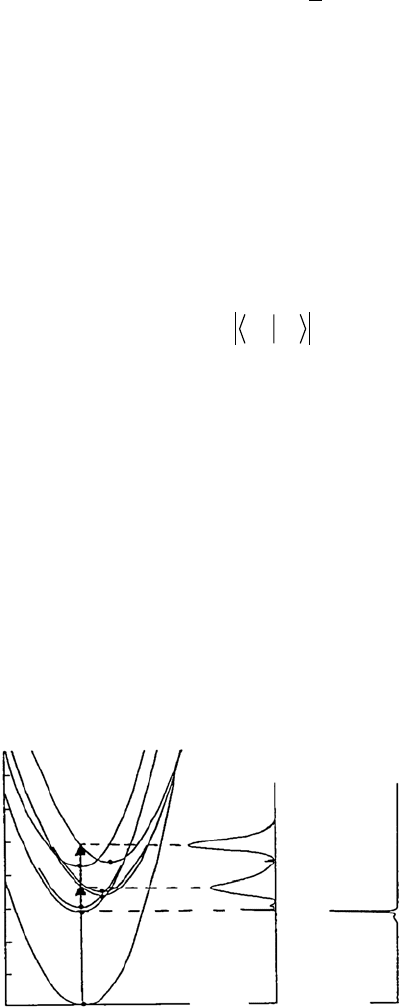
12. Luminescence Spectroscopy
534
2
0
1
Ȧ
2
Sk = a
, (12.83)
where Zis the angular vibrational frequency of the system.
S
0
is also the average
number of phonons created or destroyed in the transition [17]. The physical
meaning of
S
0
can be understood in the following manner. The lattice motion
induces a local strain, which depends on the electronic state of the ion. If the
strain is similarly affected for two electronic states, the value of
S
0
between those
two states is small. If two states affect the strain very differently, then
S
0
will be
large. The constant
S
0
, then, describes the relative coupling of the electronic
wavefunctions to the vibrationally induced strains in the lattice.
Enforcement of the Franck-Condon principle leads to the result that the
strength of a transition from ¸v
m
² to ¸u
n
² is proportional to the square of the
overlap between the vibrational wavefunctions of the two states:
2
m,n m n
W
v
II . (12.84)
These overlap integrals are called the
Franck-Condon factors. In thermal
equilibrium, the vibrational levels of the initial electronic state are populated
according to the Boltzmann distribution, so that
W
m,n
has an inherent temperature
dependence.
A CC model for ruby (Cr
3+
:Al
2
O
3
) is shown in Figure 12.9, along with the
absorption and emission spectra. Note that the transitions from the ground
4
A
2
state to the upper
4
T
1
and
4
T
2
states, are spin-allowed. The
4
T
1
and
4
T
2
states are
offset from the
4
A
2
state, and so exhibit broad absorption bands. In emission, the
situation is different. Following absorption into the
4
T
2
state, the ion relaxes to
the base of the
4
T
2
parabola, emitting phonons in the process. From that point,
there is a feeding into the
2
E state, which is accompanied by the further emission
42
2
Eo
4
A emission is a sharp line. (This is the 694-nm ruby laser emission line.)
This transition is between states of different spin, and so it is weak. The lifetime
of the
2
E state is correspondingly long at 3 ms.
Figure 12.9 The configurational coordinate diagram and absorption and emission spectra of Cr
+3
:
Al
2
O
3
[18].
Al
2
O
3
:Cr
+3
Energy (cm
−1
× 10
−3
)
4
T
1
2
T
2
absorption
emission
4
T
2
4
A
2
2
T
1
2
E
0
5
10
15
20
25
30
35
of phonons. Because there is a small offset between the A and E states, the

12.4 Localized Systems
535
12.4.5 Color Centers in Solids
12.4.5.1 Introduction
Even the purest crystals are found to have defects in the crystalline structure.
The defect centers of concern in this section are color centers, some of which are
given in Table 12.2. These are most widely found in alkaline halides, though
they also occur in oxides, fluorides, and other miscellaneous hosts. Unless
otherwise stated, our discussion assumes alkaline halide host materials.
Table 12.2 Color centers in alkaline halides.
Color Center
Description in Alkaline Halides
F One electron trapped at an anion site
F
–
Two electrons trapped at an anion site
F
+
Vacant anion site
F
2
(M) Two neighboring F-centers along the 110 axis
F
2
+
Two neighboring vacant anion sites (along 110 axis)
containing a single electron
F
3
(R) Three neighboring F-centers forming an equilateral triangle
F
A
F-center adjacent to a smaller alkali impurity ion
V
K
Singly ionized halogen-ion molecule formed from two
adjacent halides
12.4.5.2 Energy Levels of F Centers
A single crystal often contains more than one type of color center. Consequently,
the spectra often show several broad bands in absorption. The simplest of these
centers is the F center, which consists of a single electron trapped at an anion
vacancy (Figure 12.10). F centers can be formed either chemically or by
bombardment with particles (e
–
, p
+
, neutrons) or high-energy radiation
(ultraviolet, X-ray, J-ray). A more complete discussion of F centers can be found
in [19].
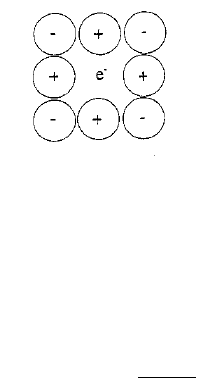
12. Luminescence Spectroscopy
536
Figure 12.10 The F center, a trapped electron at an anion vacancy.
In cubic lattices, such as alkaline halides, the obvious physical model for the
F center is that of a particle in a three-dimensional box of length 2
l, where l is
the distance from the center of the vacancy to the nearest alkaline cation. The
energy difference between the two lowest levels of such a particle is
22
2
3ʌ
8
E
ml
'
=
, (12.85)
where we note the
l
–2
dependence. Data on the low energy absorption band of F
centers in several alkaline halides are found to obey the following (Mollwo-Ivey)
law: '
E = 17.7(l)
–1.84
. The nearly l
–2
dependence lends some credibility to the
particle-in-a-box model. Generally, absorption spectra show only one excited
level associated with an isolated F center before the onset of the conduction
band.
The F center has also been described as a hydrogen-like atom, where the
electron is held at a central location by the surrounding charge rather than pulled
in by the nucleus. In the so-called “point-ion” approximation, the electron moves
in a spherically symmetric potential. The energy level structure is similar in
some ways to that of a hydrogen atom; the first energy level is well separated
from the ground state, and then numerous closely spaced levels entering the
conduction band of the solid.
The states of the color center are labeled according to the irreducible
representations of the site symmetry. For alkaline halides the ground and first
excited states are *
1
+
and *
4
–
, respectively. It is found that the lowest electronic
states exhibit character consistent with 1s and 2p states of the hydrogen atom.
The s- and p-type states emerge naturally from the point-ion model. Even the
particle-in-a-box ground and first excited state wavefunctions show s and p
character, respectively (Figure 12.11).
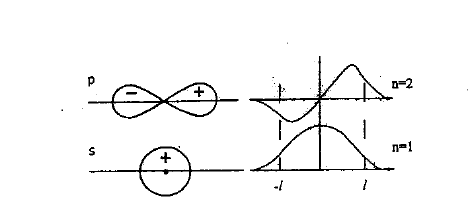
12.4 Localized Systems
537
12.4.5.3 Spectral Features of F Centers
The potential in which the electron is situated is determined completely by the
charge distribution of the nearby ions. As a result, the coupling between the F
center and the lattice is strong, and absorption and emission spectra exhibit broad
bands and large Stokes shifts, on the order of 1 eV. Figure 12.12 shows the
absorption and emission of an F center in KBr. No zero phonon line is observed,
and absorption and emission bands show no structure, even at low temperature.
A configurational coordinate diagram of an F center has a large offset between
the ground and excited state parabolas, and a Huang-Rhys parameter S
0
on the
order of 30.
Absorption from the 1s state to the 2p state is an allowed transition with an f-
number on the order of unity. Because of the relaxation of the nearby ions
following excitation, the matrix element driving the emission process can be
very different from that responsible for absorption. If the transition is from a p-
state to an s-state, the f-number will again be close to 1.
The quantum efficiency of emission from the 2p state is close to unity at low
temperatures. As the temperature is raised, the quantum efficiency decreases due
to the presence of one or more quenching processes. One such process is
nonradiative decay from the 2p to the 1s state. Another process is thermal
activation from the occupied 2p state into the conduction band. Following
absorption, the 2p state moves to within a few tenths of an eV of the conduction
band. Photoconductivity experiments show thermal activation into the
conduction band at temperatures around 100 K, depending on the host. Other
quenching processes, including the interaction with other centers, have also been
proposed [21]. At room temperature, the luminescence from F centers in alkaline
halides is often severely quenched. Most color center lasers operate at liquid
nitrogen temperature for this reason.
Figure 12.11 Diagram comparing the s- and p-type hydrogenic wavefunctions to the n = 1 and
n = 2 wavefunctions of a particle in a finite well.
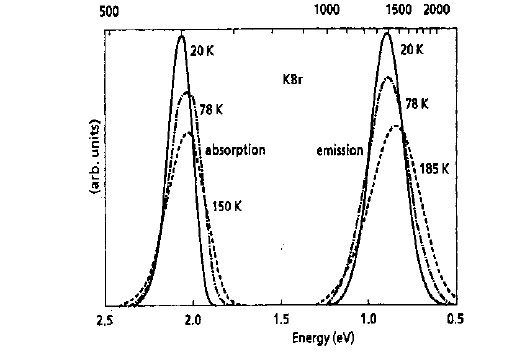
12. Luminescence Spectroscopy
538
Figure 12.12 Absorption and emission bands of an F center in KBr at different temperatures [20].
12.4.5.4 Other Color Centers
We briefly describe the optical properties of two other color centers, the F
A
center in alkaline halides and the F
+
center in oxides. The F
A
center (Figure
12.13) is an F center in which a neighboring halide ion is replaced by a smaller
halide ion, e.g., Na
+
replaces K
+
in KCl. This reduces the symmetry of the F
center from cubic to tetragonal, and splits the excited 2p triplet into two levels.
The splitting is on the order of 0.2 eV. An energy level diagram is shown in
Figure 12.13b. Optical absorption measurements show one transition polarized
along the vacancy-impurity ion axis and a twofold degenerate transition
polarized perpendicular to that axis. The emission spectrum shows a singe band.
Finally, we consider an F
+
center in oxides (Figure 12.14). By definition, an
F
+
center is one in which the net charge of the center is +1 with respect to the ion
that would normally occupy that site. Since the oxygen has a charge of –2 in
solids, the F
+
center has one electron at an oxygen vacancy, analogous to the F
center in alkaline halides. Because of the net positive charge at the vacancy site,
the electron is bound more tightly to the vacancy than in alkaline halides. Both
the ground (1s) and excited state (2p) wavefunctions are more localized, and so
the coupling to the lattice is less than for an F center in alkaline halides.
Consequently the absorption and emission bands show vibronic structure and a
relatively small Stokes shift, a few tenths of an eV (e.g., Figure 12.14b).
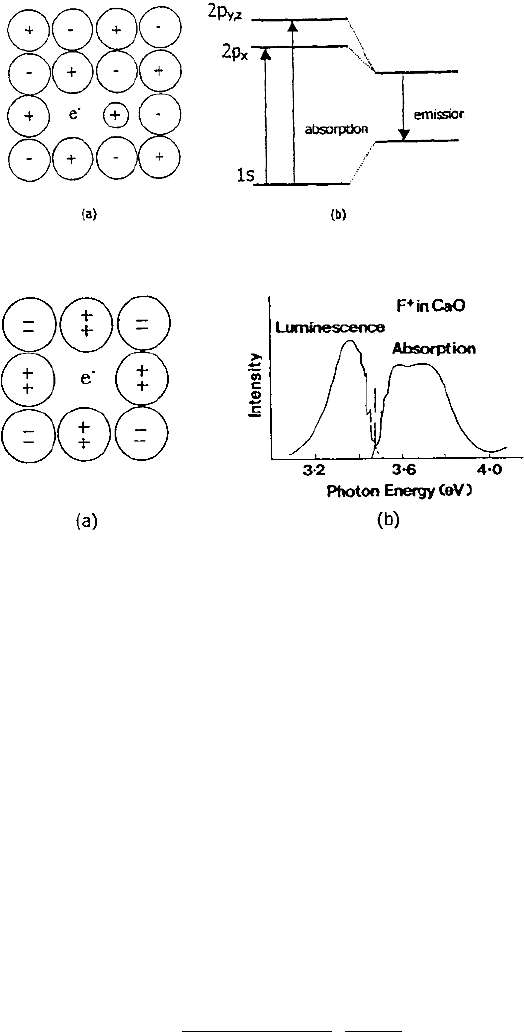
12.5 Processes in Localized Systems
539
Figure 12.13 (a) F
A
center and (b) its energy level diagram.
Figure 12.14 (a) The F
+
center and (b) absorption and emission spectra of an F
+
center in CaO at
12.5 PROCESSES IN LOCALIZED SYSTEMS
12.5.1 Introduction
The processes affecting the spectral characteristics of optically active centers
include both radiative and non-radiative types. In this section we discuss the
origin of these processes and their effects on the luminescence properties of the
system.
Of the non-radiative processes, many of them include the emission and/or
absorption of phonons. In fact, phonon-related processes are important to the
luminescence properties of virtually all optically active centers, even those
where the ion is only weakly coupled to the lattice. To understand why this is so,
recall that the density of phonons for a monatomic solid in the frequency range
between Z and Z+ dZ is:
2
23
13Ȧ
(Ȧ) ȦȦ.
exp( Ȧ /)12ʌ
s
nd d
kT c
ªº
«»
¬¼
=
(12.86)
4K [22].
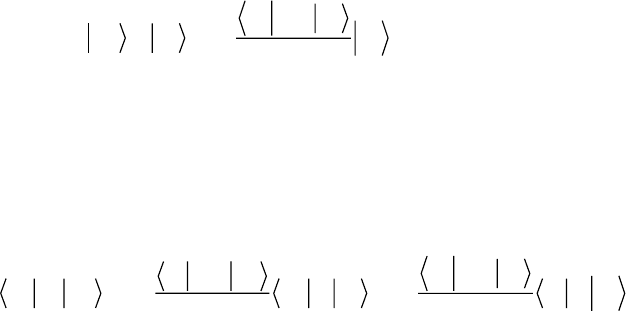
12. Luminescence Spectroscopy
540
With the velocity of sound in a solid (c
s
) on the order of 5×10
5
cm/sec, assuming
T = 300 K and a Debye temperature of 1000 K, the total number of phonons is on
the order of 10
23
/cm
3
. This high phonon density makes phonon-related processes
ubiquitous, affecting all the spectral characteristics (e.g., intensity, lineshape,
linewidth, and lifetime) of optical centers in solids.
12.5.2 Radiative Decay
12.5.2.1 Radiative Transitions Between f-Levels of REI in Solids
The probability of absorption or emission of radiation is determined by matrix
elements of the form \
a
D \
b
, where D is the operator responsible for the
transition. For rare earth ions in gaseous form, the 4f-states are of odd parity. If
D is the electric dipole operator, which is odd, then the matrix element vanishes.
Thus, electric dipole transitions between f-states are forbidden. In a crystal,
however, such transitions are frequently observed. In this section, we show that
this is because the crystal field interaction mixes some of the character of the
upper nearby configurations of opposite parity (e.g., 5d and 6s) into the 4f states.
Because H
CF-static
is small, we treat it as a perturbation. We define and u'
to be the free ion states of the 4f and 5d configurations, respectively. To the first
order in the perturbation, the 4f state of the ion in a solid, \ , is
odd
ȥ
jk
kk j
j
kj
uV u
uu
EE
c
c
c
¦
. (12.87)
The sum is over all free ion states belonging to the 5d configuration,
V
odd
represents the odd components of H
CF-static
, and E
k
and E
c
j
are the energies of u
k
and u
c
j
, respectively. When there is inversion symmetry at the rare earth ion
site,
V
odd
= 0 and no mixing occurs. If the ion site lacks inversion symmetry,
mixing is always present.
The matrix element of the electric dipole operator between two states of the
type given by equation (12.87) is:
odd
odd
ȥȥ .
jk
lm
lk mk lj
mj
lm k j
uV u
uV u
eueuueu
EE E E
c
c
c
c
cc
¦¦
rrr
(12.88)
Transitions are driven by the square of equation (12.88). Since the terms of the
form u
l
er u
c
j
2
are nonzero, electric dipole transitions between 4f states can
occur whenever V
odd
z 0. Transitions of this type have f-numbers on the order of
10
–6
.
We note that magnetic dipole and electric quadrupole transitions are allowed
even among pure f-states, and obey the selection rules, 'L, 'J 1 and 'L, 'J
2, respectively. Transitions are frequently observed, however, with 'L and 'J as
|u²
| ²
| ²
| ²
|
|
²
|
|
|
²
|
²
²
| ²
